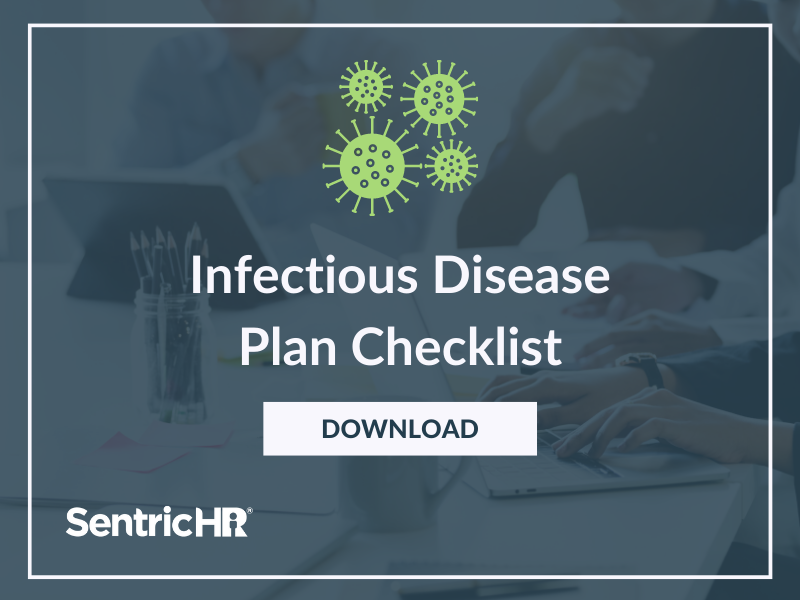The risk of COVID-19 hasn’t fully disappeared, yet life seems to be nearing what it was circa late 2019. Businesses have reopened, and some employers have adopted a hybrid return to work model to bring employees back to the physical work site.
Returning to work is necessary for many businesses to stay afloat, it also opens the door to various employee health and safety concerns.
Many employers are implementing new policies, procedures, and incentives to address concerns, possible complaints, and employee push-back.
This blog outlines expert opinions and current best practices, so you can manage and execute a successful return to office plan.
Infectious Disease Management Plan
Create a detailed plan for infectious diseases like the novel coronavirus. With a plan already prepared, you’ll reduce errors that could result from hastily written procedures. Make sure your plan includes:
- Travel restrictions. Limit business trips to high-risk areas, or limit non-essential travel altogether, to keep exposure and infection to a minimum. Use your discretion and the latest updates from health authorities to help guide your decision.
- Protocols for “stranded” travelers in quarantine. Outline guidelines for remote work (if possible), HR support, and employee compensation.
- Reporting procedures. Explain how to report potential workplace infection to the proper personnel.
- Shutdown strategy. Plan for a potential organization closure. Include a plan that will help your organization resume operations after a shutdown, too.
Work with a lawyer to ensure your infectious disease management plan is compliant. Your plan should also include some general methods like the ones outlined below.
General Prevention Methods
You can lower the risk of infection with general prevention measures. Share this list with your employees and include it in your infectious disease plan.
- Wash your hands. The CDC recommends washing your hands with soap and water for at least 20 seconds.
- If you can’t wash your hands, use a hand sanitizer with at least 60% alcohol.
- Avoid contact with sick people. If you feel unwell, stay at home.
- Don’t touch your face, especially your eyes, nose, and mouth.
- Cough or sneeze into a tissue, then throw the tissue into the trash.
- Replace handshakes with an elbow bump or similar – avoid direct hand-to-hand contact.
- Use disinfectant to regularly clean shared surfaces (physical time clocks, water coolers, door handles, etc.). Wear disposable gloves and use a diluted bleach or 70% alcohol-based solution.
Return to Work Policy
If you need to physically return to work, develop a Return to Work policy. This should detail your response to COVID-19 and how you plan to resume operations safely. A comprehensive plan will include sanitation measures, social distancing guidelines, Personal Protective Equipment (PPE) requirements, and compliance with Federal, state, and local guidance.
As the last step, survey your employees to identify their significant concerns. This will create a space where they genuinely feel safe.
Employee Communication Schedule
Misinformation can spread faster than a virus. You should not assume the role of a health expert, but you can point your employees toward the appropriate resources.
Email employees so they know what you’re doing to lower the risk of disease in the office. Continue to update employees as the virus spreads and your organization makes changes. If you haven’t already, send an email reminding employees to stay home if they develop symptoms or feel unwell. You may want to share known disease symptoms with your workforce so they know what to look for.
Remote Work Policy
Many organizations urge employees to work remotely to prevent the spread of disease. In the event of a quarantine, remote work may become necessary to keep the business running (as long as employees are healthy). If this happens, it’s best to have a remote work policy. This policy should include:
- Eligibility. Explain which positions are eligible for remote work.
- Guidelines. Employees may be unfamiliar with digital interviews, meetings, and conferences. Provide guidelines for best practices to help them acclimate.
- Effective Software. Give employees the resources they need to work from home. This may include instant messaging platforms and project management tools.
- Data security policies and instructions. Ensure employees are well-versed in data security and know how to connect to your VPN.
- Support. Remote work may cause employees to ask more questions than usual. The change in routine may also leave them disconnected and distracted. Create check-in policies to ensure that everyone’s getting the support they need.
Updated Sick Leave Policy
To lessen the risk of exposure, the CDC has urged people to stay at home if they feel sick. Despite this warning, many employees don’t have paid sick leave and can’t afford to take an unpaid day off. Others are afraid they’ll be penalized for calling off. They come to work, even if it means putting their coworkers and clients at risk.
Make sure your employees know that they won’t be penalized for calling off sick. If you can, provide paid sick leave, so employees feel free to take time off and recover.
HIPAA & FMLA Compliance
Even amid infectious disease, you need to remain compliant. Under HIPAA, for instance, covered entities are not required to share protected health information with you. They only share this information when it’s necessary to treat a patient or protect public health. In addition, under FMLA, infected employees and employees with infected family members may be entitled to FMLA leave.
Anti-Discrimination Measures
In the case of the novel coronavirus, people of Asian descent may face discrimination. Remind employees that viruses do not choose hosts based on race or nationality. Reiterate that discrimination in any form will not be tolerated.
Consider a Vaccine Policy
Depending on state requirements, more vaccinated employees will mean less compliance risks. Greater vaccination rates can also reduce your workload – you won’t have to check an overwhelming amount of COVID-19 test results each week.
All Federal workers must be fully vaccinated. This includes employees of contractors that do business with the Federal government.
Likewise, healthcare workers at participating Medicare and Medicaid settings must be fully vaccinated. These healthcare settings include, but are not limited to, hospitals, dialysis facilities, and home health agencies.
Implementing any new policy can be challenging, and a vaccine-related one is certainly no exception. But whether you’re concerned about employee reactions or something else, you may want to reconsider a vaccine policy if you don’t have one already because there are quite a few things to consider.
Mandatory Vaccinations vs Weekly Testing
To start, decide if your business will require vaccination or allow weekly testing. How will you track vaccination? Do you have someone who will be able to check employee test results each week? Depending on your bandwidth, creating a mandatory vaccine policy may be easier for your business.
You’re not required to cover the cost of weekly COVID-19 testing for your employees, but you may want to consider your budgetary constraints regardless. Collective bargaining agreements and other factors may require you to bear some financial responsibility. In cases such as this, mandatory vaccination may be more reasonable for your business since vaccines are free.
Cost of Testing
Under the Federal mandate, employers were not required to pay for, or provide testing to, employees who chose not to receive the vaccine. (Health plans and insurance carriers are now required to cover the cost of at-home over-the-counter COVID-19 tests.) However, you may need to note collective bargaining agreements or other circumstances that could require otherwise if you face state or local requirements.
Exemptions
Once you decide on your strategy, make sure your vaccine policy includes the proper exemptions for people with qualified medical conditions, disabilities, and sincerely held religious beliefs. Consult your legal advisor for additional help.
Anticipate Accommodation Requests
As noted above, many vaccine requirements do not override certain exemptions for people with qualified medical conditions, disabilities as defined under the Americans with Disabilities Act, and sincerely held religious beliefs as defined under Title VII of The Civil Rights Act.
To confirm that an employee has a qualifying medical reason for exemption, you’re allowed to request verification from them. However, be sure to keep all medical information confidential. You should also try to stay consistent when requesting verification.
When it comes to religious beliefs, many religious objections are protected. You should only seek additional verification if you have a specific reason to doubt that an employee’s objection is religion-based.
Prepare for Employee Concerns
Some employees will be concerned about vaccine requirements. Be sure to explain the reasoning behind your policy. Let employees know that, as a business, you need to comply with state or local requirements (if applicable). Show them that your policy is also meant to keep them and their workplace safe.
When employees express their concerns, listen to them carefully. You may be able to work out a reasonable accommodation, like weekly testing instead of vaccination. Other employees may be willing to get the vaccine, but still feel anxious about new policies and workplace changes. You can support them with mental health programs and other initiatives.
Hazard Pay
If you employ frontline workers, you may have heard of COVID-19 hazard pay. Hazard pay is additional pay given to individuals who work with physical hardship or hazardous duties. Miners, construction workers, and individuals in similar positions receive this compensation.
During a pandemic, workers on the frontlines also risk their health and safety when they go to work each day. Hazard pay is one way to show appreciation for those employees returning to work in such unusual circumstances. By compensating employees a little extra, you show them that you’re aware of the dangers they face and care for their wellbeing.
Hazard pay can’t eliminate complaints, but it can reduce initial grievances.
The Department of Labor does not mandate hazard pay. It’s optional, even during the COVID-19 pandemic. You have the power to decide whether to offer it, which employees are eligible, and how much you will award.
As long as your hazard pay doesn’t exceed 25% of an employee’s standard wage rate, you can pick any amount you like. If you need some guidance, there are several example policies online that can help you get started. This example from SHRM is just one approach you can take.
Please note: If you received funding from the PA Hazard Pay Grant Program, you must adhere to that program’s guidelines regarding your policy and how you distribute the funds.
Notices, Acknowledgements, and Waivers
If you can’t provide hazard pay (or even if you can), you may consider notices, acknowledgments, and waivers. Many employers are using these documents to reduce their liability for COVID-19 risks.
However, experts don’t know how enforceable these documents are. Most agree that their protections are limited to specific situations. Federal, state, and local laws also can overrule them. So, are they helpful in managing concerns and complaints? It depends on the document and your unique situation.
Notices
Written notices outline the precautions you’re taking during the pandemic. They help make employees and clients aware of your standards and what they need to do to comply with them. Most experts agree there’s no downside to displaying these notices around your workplace. They don’t offer liability protection, but they can promote safety awareness.
When writing your notice, be sure to include the appropriate disclaimers. For example, you should note that your safety measures are not diagnostic. You cannot guarantee that everyone who enters your workplace is COVID-19 free. Likewise, you cannot eliminate the risks of contracting or spreading the disease.
Acknowledgments
Acknowledgments ask your employees to understand and comply with your return to work and safety policies. Most experts say that no harm can come from getting written consent from your employees. Others take this a step further, arguing that acknowledgments are unnecessary unless required by state or local law.
According to them, employers don’t need employee consent to protect their workplace. This includes implementing safety procedures during a pandemic. Employees always have the right to refuse temperature checks or questionnaires. But employers also have the right to deny them entry to the workplace if they fail to comply.
If your local or state laws require acknowledgments, you’ll need to use them. But if they aren’t required, the decision is up to you. They may not be necessary, but they’re another way to ensure your employees know your policies and what they need to do.
Waivers
Waivers aim to reduce an employer’s liability for COVID-19-related risks. Right now, many employers are asking employees and customers alike to sign them. However, waivers are only enforceable in specific situations. Whether a waiver can offer protection depends on your specific situation and relevant state and local laws.
They may offer limited protection from negligence claims. But they can’t protect you from gross negligence or willful conduct. They cannot overrule workers’ compensation statutes or OSHA complaints and investigations.
And if your business fails to comply with OSHA and CDC regulations and Federal, state, and local COVID-19 guidance, you will still be liable even if your employees sign a waiver. In Virginia, Louisiana, Montana, and Connecticut, waivers are not enforceable contracts.
Some experts point out that waivers can harm your employees. They may make employees reluctant to return to work. Because their enforceability is limited, waivers may not be worth the potential hit to employee morale.
Other experts note that although their protections are limited, waivers can act as a deterrent for employees who wish to file complaints or pursue legal action. Speak with your legal advisor to learn more about waivers and whether they can help you.
Complaints
Coronavirus cases spike and fall, legislation changes, and new guidance arrives weekly. As a result, your return to work may not be perfect. Even if you provide hazard pay and comply with all guidance, you may still receive health and safety complaints from employees.
How you handle these complaints will show your employees how much you value their health and safety. Your response can reduce their fears or add to their worries. So whether the complaint is official or unofficial, it’s important to take it seriously.
Official Complaints
Under OSHA guidance, you’re responsible for providing a workplace that is safe and hazard-free. OSHA has released additional recommendations for keeping workplaces safe during the COVID-19 pandemic. If one of your employees feels that your workplace is not safe, they may file an official OSHA complaint. Hopefully, this never happens to you, but if it does, here is what to expect:
First, OSHA will evaluate the employee’s complaint to ensure that there are “reasonable grounds to believe that a violation of an OSHA standard or a safety or health hazard exists.” Based on the severity of the complaint and other factors, OSHA will proceed with an off-site or on-site investigation.
- If the complaint does not detail imminent danger, OSHA will likely proceed with an off-site investigation. A representative will call you and outline the hazard complaint, then follow up with a fax or letter.
- You have five days to respond to OSHA. Identify any problems or issues found at your workplace, and note the corrective safety procedures you will take to remove them.
- If your response is adequate, OSHA will not conduct an on-site inspection. However, if you don’t respond (or if your response has a glaring non-safety measure), OSHA may conduct an on-site inspection. Likewise, if the complainant is unsatisfied with your response, they can request an on-site inspection.
- Unless there is an immediate threat, on-site investigations are relatively rare. Regardless, if you receive an official complaint, take the time to develop a response that reprioritizes the health and safety of your employees.
Unofficial Complaints
Employees may voice their health and safety concerns unofficially, too. Maybe someone tells you that their coworker isn’t wearing a protective face covering. Maybe someone is concerned about the lack of sanitation tools.
These aren’t formal complaints, but you should still investigate them. Do what you can to eliminate those concerns. If necessary, remind your employees of your policies and that disciplinary action may follow if they fail to comply.
Whether it’s hazard pay, waivers, or something else, managing health and safety concerns during a pandemic is complex and uncertain. Unfortunately, there’s no way to eliminate employee concerns or complaints. There will always be some risk.
Similarly, the current state of the world has many people feeling stressed and frustrated. Your employees may express concerns and complaints simply because they have no other outlet right now. The only thing you can do is comply with all guidance, follow best practices, and make sure employees feel safe when they come into work.
It’s important to note that this information may change with additional guidance from Federal, state, or local entities. Currently, there is no formal guidance, although new laws are being proposed to limit employers’ liability who follow all Federal, state, and local regulations. Under these laws, employers would be protected from COVID-19 lawsuits (as long as they comply with all safety procedures).
If you need additional help with COVID-19 guidance, Sentric can help.
Download our Employer’s Interactive Guide to COVID-19 Legislation, which has everything you need to stay on top of the latest changes.
Update Your Company Policy
Various aid programs aren’t the only changes COVID-19 brought to the workplace. The pandemic also introduced new practices that may have a long-term impact on your company policies.
From sick leave procedures to sanitation requirements, it’s important to update your handbook and policies with any changes your business has made due to COVID-19. After all, clear policies can help ensure employee compliance and reduce potential liabilities.
The following questions can help you determine what policy updates you need to make:
- Did you change your sick leave policies due to COVID-19?
- Are you voluntarily providing FFCRA-related leave? If so, how do you track this leave?
- Have you changed your attendance policies? Did you create flexible schedules or stagger meal times to encourage social distancing?
- What are your company procedures for social distancing, wearing masks, reporting illnesses, and maintaining other health and safety measures?
- Have you restricted business travel or required employees to notify you of personal travel?
- Is remote work new to your business? Has your remote work policy changed? Have you updated your reimbursement policy for remote work?
- Did you add new covered benefits as a result of COVID-19? Did you edit your COBRA and FSA documents with the latest updates?
From attendance and travel policies to health insurance and safety measures, this checklist outlines the major items you may need to update in your existing company handbook.
Guide to COVID-19 Legislation
In addition to preparing your workplace for infectious disease, The COVID-19 pandemic has prompted a variety of new laws and regulations, including the FFCRA and CARES Act. Our comprehensive guide helps employers understand how their business may be impacted by COVID-19 legislation, what they need to do, and how their HR or payroll provider can help.
The COVID-19 pandemic has caused business shutdowns and record-breaking levels of unemployment. To provide some relief during these unprecedented times, the Federal Government passed several pieces of legislation, including the Families First Coronavirus Response Act (FFCRA) and the Coronavirus Aid, Relief, and Economic Security (CARES) Act. Both of these Acts have complex provisions impacting individuals, businesses, and certain private and governmental entities, which can make it difficult to understand how they impact you and your business.
We created this interactive guide to help you, as an employer, navigate the required compliance and the different loans, grants, tax credits, and tax deferrals available to your business during this time.
This guide will help you navigate the main features of COVID-19 legislation, including:
- Emergency Paid Sick & Emergency Family and Medical Leave
- Emergency Paid Sick & Emergency Family and Medical Leave Tax Credits
- Paycheck Protection Program (PPP) Loan
- Economic Injury Disaster Loan (EIDL) and Emergency Loan Advance
- Employee Retention Credits
- Employer Payroll Tax Deferral
Implement an HRIS Software
Infectious diseases can limit your business continuity. However, an HRIS system lets your organization function remotely. Employees can access paychecks, track time, and sign documents online. You can post announcements and manage employees across the country. No physical interaction is necessary, and your work can continue uninterrupted.
Because your employees will use the HRIS daily, you won’t need to do a “trial run.” Everyone will already be familiar with the platform, and no adjustment period will be needed.
With one platform for payroll, benefits, and HR, we make people management easier.
Contact us today to find out more about how we can support you and your employees during COVID-19.
Legal Disclaimer: The information contained in this guide is for general informational purposes only. Under no circumstance shall we have any liability to you for any loss or damage of any kind incurred as a result of the use of the template or reliance on any information provided in this template. Your reliance on any information is solely at your own risk.











